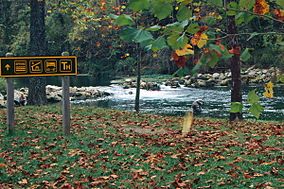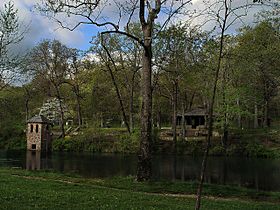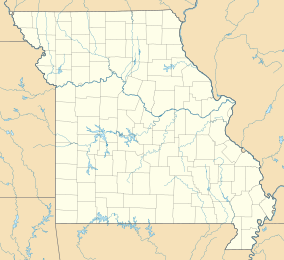Bennett Spring State Park facts for kids
Quick facts for kids Bennett Spring State Park |
|
|---|---|
 |
|
| Location | Dallas, Laclede, Missouri, United States |
| Area | 3,216.74 acres (13.0177 km2) |
| Elevation | 1,076 ft (328 m) |
| Established | 1924 |
| Governing body | Missouri Department of Natural Resources |
| Website | Bennett Spring State Park |
|
Bennett Spring State Park Shelter House and Water Gauge Station
|
|

Historic water gauge station and shelter house
|
|
| Location | Dallas / Laclede counties, Missouri, USA, near Bennett Springs, Missouri |
| Area | Less than one acre |
| Built | 1933 |
| Built by | CCC; NPS |
| MPS | ECW Architecture in Missouri State Parks 1933-1942 TR |
| NRHP reference No. | 85000527 |
| Added to NRHP | February 28, 1985 |
|
Bennett Spring State Park Hatchery-Lodge Area Historic District
|
|
| Location | MO A64, Bennett Spring, Missouri |
| Area | 20 acres (8.1 ha) |
| Built | 1933 |
| Architect | CCC |
| MPS | ECW Architecture in Missouri State Parks 1933-1942 TR |
| NRHP reference No. | 85000504 |
| Added to NRHP | March 4, 1985 |
Bennett Spring State Park is a fun place in Missouri where people can enjoy nature. It's located near Bennett Springs, Missouri, about 12 miles (19 km) west of Lebanon. The park is famous for its big natural spring. This spring flows into the Niangua River and gives the park its name.
The spring is huge, with about 100 million gallons (380,000 m3) of water flowing out every day! The park offers many cool activities. You can go fly fishing, camping, canoeing, or hiking. It's a great spot for outdoor adventures.
Contents
Park History
Long ago, in 1837, a family named Brice built a mill by the stream. People started calling the spring "Brice Spring." A small town grew up there, also called Brice.
Later, the Peter Bennett family moved nearby and built their own mill. At first, the Brice and Bennett families were rivals. But soon, their children married each other. Sadly, both of these early mills were washed away in a flood.
During the Civil War, Peter Bennett built a new mill. This "Bennett Mill" was bigger and did very well. Because of its success, the spring soon became known as Bennett Spring. Peter Bennett passed away in 1882, and his son, William Sherman Bennett, took over the mill. However, the Bennett Mill burned down in 1895.
In 1924 and 1925, the state of Missouri bought the spring and the land around it. This is how Bennett Spring State Park was created. In the 1930s, a group called the Civilian Conservation Corps (CCC) helped improve the park a lot.
The CCC was a program during the Great Depression. Young men worked on projects to help the country. At Bennett Spring, they built many important things. They constructed the dining lodge, cabins, and hiking trails. They also made roads, shelters, and a water gauge station.
One special thing they built is the arched stone bridge over the spring branch. This bridge has three unique sideways "C" shapes. These "C"s are a way to remember the men of the CCC who built it. The CCC also changed the spring branch to make it better for trout. They built a dam upstream from the stone bridge. This dam helps send water to the fish hatchery and keeps the water level steady in the spring.
Historic Buildings and Sites
Bennett Spring State Park has two areas that are very important historically. They were added to the National Register of Historic Places in 1985. This means they are recognized as special places that should be protected.
- Bennett Spring State Park Hatchery-Lodge Area Historic District: This area includes several buildings and structures. They were all built by the Civilian Conservation Corps (CCC) between 1933 and 1938. These include two stone bridges, a barn, a storage building, and the old "Hotel" where officers stayed. There is also a restroom and the park's dining lodge. These buildings show the amazing work the CCC did.
- Bennett Spring State Park Shelter House and Water Gauge Station: This site features a picnic shelter and a water gauge station. The picnic shelter is made of wood and stone. It has a cozy fireplace inside. The water gauge station is a small, two-story stone tower. It has a pyramid-shaped roof and arched windows. These structures are also examples of the CCC's excellent building skills.
Fun Activities and Things to Do
Bennett Spring State Park is a fantastic place for outdoor activities!
Trout Fishing
The park is famous for its trout fishing. You can catch rainbow and brown trout in the spring. The fishing area is split into three different zones. Each zone has its own rules about how you can fish.
During the main fishing season, you can catch fish and keep them. In the winter months, there are "catch and release" rules. This means you catch the fish, but then you must let them go. Fishing starts and ends each day with a whistle or siren. It's fun to see everyone line up at the start of the day, ready to cast their lines!
Other Activities
Besides fishing, there are many other things to do:
- Hiking Trails: The park has about 12 miles (19 km) of hiking trails. You can explore the beautiful nature and see different plants and animals.
- Canoeing: You can go canoeing on the Niangua River. It's a great way to see the park from the water.
- Camping: The park has places where you can set up a tent or park an RV.
- Cabins: If you prefer, you can rent a cozy cabin to stay in.
- Swimming Pool: There's a swimming pool where you can cool off on hot days.
- Nature Center: Visit the nature center to learn more about the park's wildlife and environment.
- Dining Lodge: You can grab a meal at the park's dining lodge.
- Park Store: The park store has snacks, drinks, and fishing supplies.


